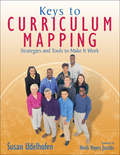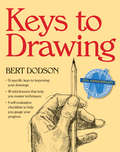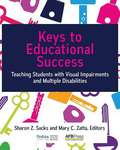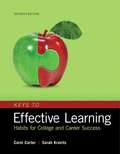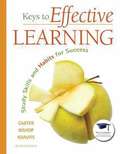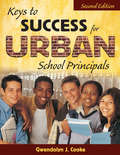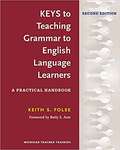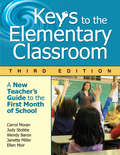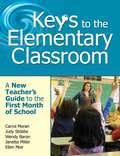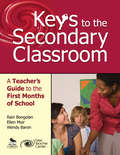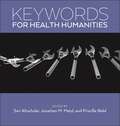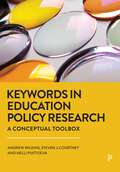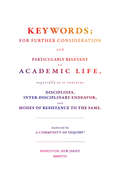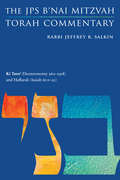- Table View
- List View
Keys to Curriculum Mapping: Strategies and Tools to Make It Work
by Susan K. UdelhofenPacked with templates, flowcharts, tips, and troubleshooting techniques for curriculum mapping, this practical resource provides the tools necessary for successful implementation and exciting results.
Keys to Drawing: Strategies And Excercises For Gaining Confidence And Enhancing Your Creativity (Draw Bks.)
by Bert DodsonAnyone who can hold a pencil can learn to draw. In this book, Bert Dodson shares his complete drawing system-fifty-five "keys" that you can use to render any subject with confidence, even if you're a beginner. These keys, along with dozens of practice exercises, will help you draw like an artist in no time. You'll learn how to: Restore, focus, map, and intensify Free your hand action, then learn to control it Convey the illusions of light, depth, and texture Stimulate your imagination through "creative play"
Keys to Educational Success
by Editors Sharon Z. Sacks Mary C. ZattaEvery student has unique learning needs, but addressing the diverse needs of students who have visual impairments and multiple disabilities can be particularly challenging for teachers. Keys to Educational Success helps educators unlock the learning potential of their students by providing key program strategies that can be directly applied to classroom learning routines. It includes information about the basics of assessment, IEP development, and instructional planning and design, as well as specific strategies for essential areas of instruction including communication, literacy, O&M, behavior intervention, technology, and others. Guidelines for working with very young children, as well as for preparing students for life transitions after school, are explained. Keys to Educational Success is also an important reference for special education teachers, educational team members, and administrators.
Keys to Effective Learning: Habits for College and Career Success
by Carol Carter; Sarah Lyman KravitsKeys to Effective Learning nurtures these skills in students entering college by focusing on building accountability, teamwork, and critical/creative thinking skills that can be applied to any academic or workplace setting.
Keys to Effective Learning: Study Skills and Habits for Success,Sixth Edition
by Carol Carter Joyce Bishop Sarah Lyman KravitsThe sixth edition of Keys to Effective Learning text helps students build habits for success and develop the thinking, self-management, and study skills they need to succeed academically. This edition is streamlined to focus more on essential study skills, with greater coverage of memory, studying, reading, and test-taking. It retains its acclaimed simple-to-use Critical and Creative Thinking coverage, and adds relevance by addressing the two greatest barriers to staying in school—time and money management. Recognizing that the first step in developing the independent thinking skills needed for college-level work is understanding how you think, this revision builds students’ self-awareness in three ways: embedded in-chapter self-assessments, “powerful question” features, and learning preferences grids that asks them to think about how they learn in a variety of situations. The text offers a pre- and post-course assessment. The Habits for Success theme is now more integrated and practical. Students assess which habits they’ll need in college and how to form those habits so they have the tools to increase their preparedness, confidence, and commitment to learning.
Keys to Success for Urban School Principals
by Gwendolyn J. CookePresenting seven keys to leadership—control, caring, change, charisma, communication, curriculum, and courage—this manual provides strategies to initiate, stabilize, and sustain effective practices.
Keys to Teaching Grammar to English Language Learners: A Practical Handbook
by Keith S. Folse Betty S. AzarKeys to Teaching Grammar to English Language Learners: A Practical Handbook is not intended to be an exhaustive reference book about ESL grammar. Written for classroom teachers (K-12, ESL, EFL), this book teaches the most common ESL grammar points in an accessible way through real ESL errors together with suggested teaching techniques. Relevant grammar terminology is explained. <P><P> The four objectives of this book are to help teachers: (1) identify common ESL grammar points and understand the details associated with each one; (2) improve their ability to answer any grammar question on the spot (when on the “hot seat”); (3) anticipate common ESL errors by grammar point, by first language, and/or by proficiency level; and (4) develop more effective grammar/language learning lessons. These objectives are for all teachers, whether they are teaching grammar directly or indirectly in a variety of classes – including a grammar class, a writing class, a speaking class, an ESP class, or a K-12 class. <P><P> In the Second Edition, all chapters have been updated and substantively revised. The number of marginal (gray) boxes with tips and extra information has doubled. A 16th Key, on Negating, and three new appendixes have been added. One of the new appendixes provides a sample exercise from an actual ESL textbook plus relevant notes about the designing of grammar activities and suggestions for teaching each grammar point. <P><P> Also added to each Key is a section on the vocabulary items (e.g., collocations) that are related to the teaching of that particular grammar point. This information is unique to this edition and cannot be found elsewhere on the market. <P><P> The Workbook for the Second Edition (978-0-472-03679-0), available in 2017, includes numerous activities that practice the essentials of grammar and issues relevant to ESL teachers.
Keys to the Elementary Classroom: A New Teacher's Guide to the First Month of School
by Janette Miller Ellen R. Moir Wendy E. Baron Dr Carrol E. Moran Judith C StobbeBest practices to help you start the school year in a powerful way! This third edition of the bestseller Keys to the Classroom provides new teachers with strategies for establishing classroom procedures and building a foundation for a successful first year. Readers will find lesson plans, tips for organizing the first day, and sample parent letters in English and Spanish. The practical, easy-to-use guidebook features: An added chapter on planning and creating the classroom environment Voices of novice and experienced teachers New assessments for learning styles and preferences Revised instructional materials for English as a second language New classroom activities
Keys to the Elementary Classroom: A New Teacher's Guide to the First Month of School
by Janette Miller Ellen R. Moir Wendy E. Baron Judith C Stobbe Dr. Carrol E. MoranBest practices to help you start the school year in a powerful way! This third edition of the bestseller Keys to the Classroom provides new teachers with strategies for establishing classroom procedures and building a foundation for a successful first year. Readers will find lesson plans, tips for organizing the first day, and sample parent letters in English and Spanish. The practical, easy-to-use guidebook features: An added chapter on planning and creating the classroom environment Voices of novice and experienced teachers New assessments for learning styles and preferences Revised instructional materials for English as a second language New classroom activities
Keys to the Elementary Classroom: A New Teacher?s Guide to the First Month of School
by Ellen Moir Janette Miller Carrol Moran Judy Stobbe Wendy BaronBest practices to help you start the school year in a powerful way!For elementary teachers entering the classroom for the first time, this updated edition of the bestseller Keys to the Classroom provides practical guidelines to help you build a foundation for a successful first year.Written by a team of experts, this invaluable resource offers new teachers a daily structure and clear classroom procedures and activities to help establish a positive classroom climate and eliminate most behavior problems. This practical, easy-to-use guidebook includes lesson plans, tips for organizing the first day, and reproducible student worksheets in English and Spanish. The new edition features:* An added chapter on planning and creating the classroom environment* Voices of novice and experienced teachers* New assessments for students' learning styles and preferences* Revised instructional materials for English as a second languageWith strategies that can be adapted across grade levels, ways to develop relationships with students' families, and resources for professional development, Keys to the Elementary Classroom, Third Edition, will help you get a positive start to the school year and a rewarding career.
Keys to the Secondary Classroom: A Teacher’s Guide to the First Months of School
by Lorraine S. Bongolan Ellen R. Moir Wendy E. BaronAn easy-to-use source for all the strategies you need to thrive in the secondary classroom! Leveraging a wealth of information from the New Teacher Center, this user-friendly guide provides a solid foundation for classroom management, lesson planning, and assessment. Teachers will learn step-by-step tips for organizing standards-based curriculum across the content areas, supported by extensive reproducible forms and go-to references. This new edition also includes: Lesson plans by exemplary math and language arts teachers Guidelines for clear homework procedures Strategies for working with struggling readers Tips for maintaining contact with parents A list of key resources for secondary teachers
Keywords for Health Humanities (Keywords)
by Priscilla Wald Jonathan M. Metzl Sari AltschulerIntroduces key concepts and debates in health humanities and the health professions.Keywords for Health Humanities provides a rich, interdisciplinary vocabulary for the burgeoning field of health humanities and, more broadly, for the study of medicine and health. Sixty-five entries by leading international scholars examine current practices, ideas, histories, and debates around health and illness, revealing the social, cultural, and political factors that structure health conditions and shape health outcomes.Presenting possibilities for health justice and social change, this volume exposes readers—from curious beginners to cultural analysts, from medical students to health care practitioners of all fields—to lively debates about the complexities of health and illness and their ethical and political implications. A study of the vocabulary that comprises and shapes a broad understanding of health and the practices of healthcare, Keywords for Health Humanities guides readers toward ways to communicate accurately and effectively while engaging in creative analytical thinking about health and healthcare in an increasingly complex world—one in which seemingly straightforward beliefs and decisions about individual and communal health represent increasingly contested terrain.The online essays for all Keywords titles can be found here: keywords.nyupress.org
Keywords in Education Policy Research: A Conceptual Toolbox
by Nelli Piattoeva Andrew Wilkins Steven J. CourtneyThe field of education policy research is a dense, crowded space owing to its complicated relationship to different intellectual histories and the influence of various ontologies or ‘turns’. To aid comprehension and clarity, this book describes the history, contribution and application of over 90 keywords in the field of education policy research. It is designed as a reference, learning and teaching tool to assist students, educators and researchers with: • complex learning and teaching; • wider and background reading and knowledge building; • critical scholarship and research; • interdisciplinary thinking and writing; and • theory development and application.
Keywords in Youth Studies: Tracing Affects, Movements, Knowledges
by Nancy Lesko Susan TalburtWith recent attention to issues such as youth social exclusion, poverty, school underachievement, school violence, gang activity, sexuality, and youth’s interactions with media and the internet, youth studies has emerged as a significant interdisciplinary field. It has moved beyond its roots in subcultural studies to encompass a diverse array of disciplines, subfields, and theoretical orientations. Yet no volume exists that systematically presents and puts into dialogue the field’s areas of focus and approaches to research. As a unique blend of reference guide, conceptual dictionary, and critical assessment, Keywords in Youth Studies presents and historicizes the "state of the field." It offers theoretically-informed analysis of key concepts, and points to possibilities for youth studies’ reconstruction. Contributors include internationally-renowned field experts who trace the origins, movements, and uses and meanings of "keywords" such as resistance, youth violence, surveillance, and more. The blending of section essays with focused keywords offers beginning and advanced readers multiple points of entry into the text and connections across concepts. A must-read for graduate students, faculty, and researchers across a range of disciplines, this extraordinary new book promotes new interdisciplinary approaches to youth research and advocacy.
Keywords;: For Further Consideration and Particularly Relevant to Academic Life, &c.
by D. Graham Burnett a Community of Inquiry Matthew Rickard Jessica TerekhovAn irreverent critical lexicon of academic life and cultureThe university: The very name evokes knowledge, culture, and the magnificently universal ambition at the heart of this essential institution. Bastions of free inquiry and a free society, engines of social transformation and economic progress, enclosed gardens of ennobling reflection and creation, universities encompass the wisdom of the past and the hope of the future. Or do they? This critical glossary—written by a group of Princeton graduate students and faculty—defines fifty-eight terms common to academic life in a style that will prick both egos and consciences. From “academia” to “vocation,” “canon” to “peer review,” “discipline” to “methodology,” the book scrutinizes the often stultifying structures of modern disciplinary life, calls out a slavish devotion to “knowledge production” as the enemy of thought, and even dissects the notion of “academic excellence.” Feisty and darkly funny, passionate and deeply insightful, this book raises hard questions about teaching, research, theory, practice, and academic labor. The result is a must-read dispatch from today’s academic trenches—one that is sure to provoke discussion and debate.
Kha ri shele mulenzhe, Bugu ya mugudi 12: UEB contracted
by Ma Mugovhani Tc Ratshiṱanga Tm Tshikovhele Vr Tshikovhi• Nyangaredzo ya CAPS ya maṱhakheni nahone yo ṅwalwa nga vhaṅwali makone. • Zwifanyiso zwa maṱhakheni na mishumo ya u khwinisa mvelelo na u ṱuṱuwedza vhagudi. • Thikhedzo ya vhadededzi ya maṱhakheni u itela u vhulunga tshifhinga na u leludza u funza. • Ndeme ya maṱhakheni = u bvelela!
Kha ri shele mulenzhe: UEB uncontracted
by Ma Mugovhani Tc Ratshiṱanga Tm Tshikovhele Vr Tshikovhi• Nyangaredzo ya CAPS ya maṱhakheni nahone yo ṅwalwa nga vhaṅwali makone. • Zwifanyiso zwa maṱhakheni na mishumo ya u khwinisa mvelelo na u ṱuṱuwedza vhagudi. • Thikhedzo ya vhadededzi ya maṱhakheni u itela u vhulunga tshifhinga na u leludza u funza. • Ndeme ya maṱhakheni = u bvelela!
Khe I Kakarampundu! (drama): UBC contracted
by N. J. MunyembaneHeyi bugu I sumbedza khudano vhukati ha matshilel a tshikale na a musalauno. Khosi Vho-Maanda a vha tevheli ndila dza tshikale, vha hana u diisa ngoma dza vhatannga na vhasidzana, vha dovha vha hana u mala vhafumakazi vhanzhi. Vha tevhedza matshilele maswa ngauri vha dzia matshilele a tshikale sa a si na mushumo, naho hu na vhathu vhane vha kometshedza u tshila tshikale.
Khe I Kakarampundu! (drama): UBC uncontracted
by N. J. MunyembaneHeyi bugu I sumbedza khudano vhukati ha matshilel a tshikale na a musalauno. Khosi Vho-Maanda a vha tevheli ndila dza tshikale, vha hana u diisa ngoma dza vhatannga na vhasidzana, vha dovha vha hana u mala vhafumakazi vhanzhi. Vha tevhedza matshilele maswa ngauri vha dzia matshilele a tshikale sa a si na mushumo, naho hu na vhathu vhane vha kometshedza u tshila tshikale.
Khelu Karu Shiku class 2 - Maharashtra Board: खेळू करू शिकू दुसरी - महाराष्ट्र बोर्ड
by Maharashtra Rajya pathyapustak Nirmiti Va Abhyas Sanshodhan Mandal Puneखेळू, करू, शिकू या पुस्तकामध्ये मुलांना नवीन गोष्टी शिकण्यासाठी उपयोगी आहे. तसेच या पुस्तकामध्ये भरपूर चित्रे आहेत. ति पाहून कोणते खेळ कसे खेळावे हे कळण्यास मदत होईल. विविध शारीरिक हालचाली करणे, नवे खेळ आणि शर्यती शोधणे, साधी राखी, कागदाचे भिरभिरे, वाळलेल्या पानाफुलांपासून सौंदर्याकृती तयार करणे, कथा, संवाद, कविता, कोडी रंगकाम, शिल्प, वाद्यांची ओळख करून घेणे हे दाखवले आहे.
Khelu Karu Shiku class 3 - Maharashtra Board: खेळू करू शिकू इयत्ता तिसरी - महाराष्ट्र बोर्ड
by Maharashtra Rajya pathyapustak Nirmiti V Abhyas Sanshodhan Mandal Puneखेळू, करू, शिकू या पुस्तकामध्ये मुलांना विविध शारीरिक हालचाली करणे, नवे खेळ आणि शर्यती शोधणे, फुलपाखरू, बचतपेटी, नारळाच्या करवंटीपासून कलाकृती तयार करणे, कथा, संवाद, कविता, कोडी, रंगकाम, शिल्प, वाद्यांची ओळख करून घेणे हे सारे या पुस्तकात दाखवले आहे.
Khsitij Bhag 2
by National Council Of Educational Research TrainingThis book prescribed by central board of secondary education, India for the students of class 10th subject Hindi, studying through hindi medium. This accessible version of the book doesn’t leave any part of the book. The book is handy companion of the school and university students desiring to read facts in interesting way. NCERT books are must read for aspirants of competitive and job related examinations in India.
Ki Tavo': The JPS B'nai Mitzvah Torah Commentary (JPS Study Bible)
by Rabbi Jeffrey K. SalkinThe JPS B’nai Mitzvah Torah Commentary shows teens in their own language how Torah addresses the issues in their world. The conversational tone is inviting and dignified, concise and substantial, direct and informative. Each pamphlet includes a general introduction, two model divrei Torah on the weekly Torah portion, and one model davar Torah on the weekly Haftarah portion. Jewish learning—for young people and adults—will never be the same. The complete set of weekly portions is available in Rabbi Jeffrey K. Salkin’s book The JPS B’nai Mitzvah Torah Commentary (JPS, 2017).
